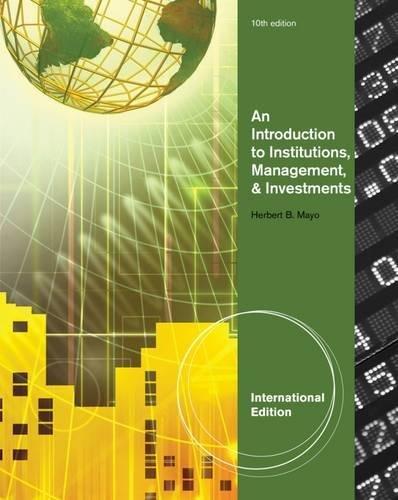Question
1) Which of the following bonds is supported by collateral? a. convertible bonds b. income bonds c. debentures d. equipment trust certificate 2) The dividend
1) Which of the following bonds is supported by collateral?
| a. | convertible bonds | |
| b. | income bonds | |
| c. | debentures | |
| d. | equipment trust certificate |
2) The dividend paid by a preferred stock is usually
| a. | tax deductible | |
| b. | fixed | |
| c. | paid in stock | |
| d. | variable |
3) Convertible bonds have
| 1. | an indenture |
| 2. | perpetual life |
| 3. | a specified conversion price |
| a. | 1 and 2 | |
| b. | 1, 2, and 3 | |
| c. | 1 and 3 | |
| d. | 2 and 3 |
4) As the price of common stock rises,
| a. | the value of convertible bonds rises but convertible preferred stock falls | |
| b. | the value of convertible bonds falls but convertible stock rises | |
| c. | the value of convertible bonds and convertible preferred stock declines | |
| d. | the value of convertible bonds and convertible preferred stock rises |
5) A price to book ratio considers
| a. | price of the stock relative to earnings | |
| b. | profits relative to equity | |
| c. | price of the stock relative to equity | |
| d. | profits relative to earnings |
6) The value of convertible preferred stock as common stock depends on
| 1. | the exercise terms |
| 2. | the dividend paid by the preferred |
| 3. | the price of the common stock |
| a. | 1 and 2 | |
| b. | 1, 2, and 3 | |
| c. | 2 and 3 | |
| d. | 1 and 3 |
7) The value of a convertible bond as debt depends on
| a. | the exercise price | |
| b. | the call penalty | |
| c. | the interest rate | |
| d. | the price of the stock |
8) An increase in investors' required return should cause the value of a common stock to
| a. | remain unchanged | |
| b. | fall | |
| c. | rise | |
| d. | remain stable or rise slightly |
9) Preferred stock and bonds are similar because
| a. | both are a source of financial leverage | |
| b. | they both have voting power | |
| c. | neither interest nor dividends are tax deductible | |
| d. | interest and dividend payments are legal obligations |
10) Common features of preferred stock include
| a. | variable, non-cumulative dividends | |
| b. | fixed, non-cumulative dividends | |
| c. | fixed, cumulative dividends | |
| d. | variable, cumulative dividends |
11) When risk analysis is introduced into the dividend growth model, the required rate of return considers
| a. | the firm's growth rate | |
| b. | the firm's beta coefficient | |
| c. | the firm's dividend | |
| d. | the firm's past dividends |
12) The value of a convertible bond as stock depends in part upon
| a. | the call penalty | |
| b. | the exercise price | |
| c. | the maturity date | |
| d. | interest rates |
13) Which of the following is not equity?
| a. | paid-in capital | |
| b. | preferred stock | |
| c. | retained earnings | |
| d. | debentures |
14) Convertible bonds lack
| a. | dividend payments | |
| b. | a maturity date | |
| c. | a call feature | |
| d. | an indenture |
15) The price of a convertible bond is often
| 1. | greater than its value as stock |
| 2. | less than its value as stock |
| 3. | greater than its value as debt |
| 4. | less than its value as debt |
| a. | 1 and 3 | |
| b. | 2 and 3 | |
| c. | 2 and 4 | |
| d. | 1 and 4 |
Step by Step Solution
There are 3 Steps involved in it
Step: 1

Get Instant Access to Expert-Tailored Solutions
See step-by-step solutions with expert insights and AI powered tools for academic success
Step: 2

Step: 3

Ace Your Homework with AI
Get the answers you need in no time with our AI-driven, step-by-step assistance
Get Started


